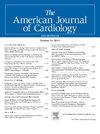IF 2.3
3区 医学
Q2 CARDIAC & CARDIOVASCULAR SYSTEMS
引用次数: 0
摘要
在急性心力衰竭(AHF)住院患者中,利尿剂抵抗(DR)很常见,可以通过 BAN-ADHF 评分来估算。在 317 名连续住院的 AHF 患者中,将 BAN-ADHF 评分与 DR 指标以及全因死亡率、HF 住院、LVAD 或心脏移植的复合终点进行了比较。BAN-ADHF 评分被纳入利尿剂剂量计算器,并追溯到患者的利尿剂剂量,将其分为剂量充足和剂量不足(不足)两类。研究的主要结果是入院后 24 小时内达到大于 3 L 的尿量。BAN-ADHF 评分的中位数为 9(IQR 为 7-13)。根据体重减轻和尿量,BAN-ADHF 分数越高,DR 越大(均 p本文章由计算机程序翻译,如有差异,请以英文原文为准。
Adequacy of Loop Diuretic Dosing in Treatment of Acute Heart Failure: Insights from the BAN-ADHF Diuretic Resistance Risk Score
Diuretic resistance (DR) is common among patients admitted with acute heart failure (AHF) and can be estimated by BAN-ADHF scores. Among 317 consecutive patients hospitalized for AHF, BAN-ADHF scores were compared with metrics of DR and composite endpoint of all-cause mortality, HF hospitalization, LVAD, or heart transplantation. The BAN-ADHF score was incorporated into a diuretic dosing calculator and retroactively applied to a patient's diuretic dose to categorize them as adequately dosed or under-dosed (inadequate). The primary outcome studied was attaining >3 L of urine output within the first 24 hours of admission. The median BAN-ADHF score was 9 (IQR of 7-13). A higher BAN-ADHF score was associated with greater DR based on weight loss and urine output (all p <0.001). The highest quartile (Q4) had fewer patients achieve the admission urinary output goal (15% vs 32%, p = 0.004) and lower total urine output (2,009 mL vs 2,559 mL, p = 0.029) compared with the first 3 quartiles. In time-to-event analysis, Q4 of BAN-ADHF score was associated with increased risk of the primary composite endpoint (HR 2.07, 95% CI 1.41 to 3.04). Compared to those below the calculator's recommended dose, patients receiving loop diuretics at goal doses (37.7% of cohort) had greater 24-hour UOP (3,050 vs 2,050 mL), likelihood of UOP goal (45% vs 19%), and weight loss at discharge (8.95 kg vs 5.94 kg; all p <0.001). In conclusion, BAN-ADHF score correlated with diuretic resistance and prognosis, and may capture the risk of DR compared traditional measures like CKD or NT-proBNP.
求助全文
通过发布文献求助,成功后即可免费获取论文全文。
去求助
来源期刊

American Journal of Cardiology
医学-心血管系统
CiteScore
4.00
自引率
3.60%
发文量
698
审稿时长
33 days
期刊介绍:
Published 24 times a year, The American Journal of Cardiology® is an independent journal designed for cardiovascular disease specialists and internists with a subspecialty in cardiology throughout the world. AJC is an independent, scientific, peer-reviewed journal of original articles that focus on the practical, clinical approach to the diagnosis and treatment of cardiovascular disease. AJC has one of the fastest acceptance to publication times in Cardiology. Features report on systemic hypertension, methodology, drugs, pacing, arrhythmia, preventive cardiology, congestive heart failure, valvular heart disease, congenital heart disease, and cardiomyopathy. Also included are editorials, readers'' comments, and symposia.
 求助内容:
求助内容: 应助结果提醒方式:
应助结果提醒方式:


